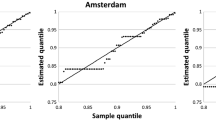Abstract
Freemium business models, where companies offer a free basic and a value-enhanced paid version of a product, have become ubiquitous across software, games and a broad range of web services. Despite the many benefits of freemium, most firms suffer from too few premium subscribers (3–5 %), which challenges their profitability. Although free trials have helped improve premium conversions, research hitherto has paid little attention towards what works effectively. Therefore, we examine the effect of two common free trial strategies on consumers’ conversion likelihood: Freefirst, where consumers start in the free and then opt into a trial of the premium version and Premiumfirst, where things are experienced in reverse order. Based on a contest-based online experiment with 225 subjects, our analysis reveals that in contrast to Freefirst, Premiumfirst significantly increases conversion propensity and that this positive effect is greater when the premium and the free version are more similar.



Similar content being viewed by others
References
Ariely, D., Huber, J., & Wertenbroch, K. (2005). When do losses loom larger than gains? Journal of Marketing Research, 42(2), 134–138.
Armstrong, J. S., & Overton, T. S. (1977). Estimating Nonresponse Bias in Mail Surveys. Journal of Marketing Research, 14(3), 396–402.
Bardsley, N. (2010). Experimental Economics: Rethinking the Rules. Princeton University Press.
Benlian, A. (2015). Web personalization cues and their differential effects on user assessments of website value. Journal of Management Information Systems, 32(1), 225–260.
Cheng, H. K., & Tang, Q. C. (2010). Free trial or no free trial: Optimal software product design with network effects. European Journal of Operational Research, 205(2), 437–447.
Chiang, K.-P., & Dholakia, R. R. (2003). Factors driving consumer intention to shop online: an empirical investigation. Journal of Consumer Psychology, 13(1), 177–183.
Dörr, J., Wagner, D.-V. T., Benlian, A., & Hess, T. (2013). Music as a Service as an Alternative to Music Piracy? Business & Information Systems Engineering, 5(6), 383–396.
Hayes, A. F. (2013). Introduction to Mediation, Moderation, and Conditional Process Analysis: A Regression-based Approach. New York. NY: Guilford Press.
Ho, S. Y., Bodoff, D., & Tam, K. Y. (2011). Timing of adaptive web personalization and its effects on online consumer behavior. Information Systems Research, 22(3), 660–679.
Jiang, Z., & Sarkar, S. (2009). Speed matters: The role of free software offer in software diffusion. Journal of Management Information Systems, 26(3), 207–240.
Kahneman, D., & Tversky, A. (1979). Prospect Theory: An Analysis of Decision under Risk. Econometrica, 47(2), 263–291. doi:10.2307/1914185.
Kahneman, D., Knetsch, J. L., & Thaler, R. H. (1990). Experimental tests of the endowment effect and the Coase theorem. Journal of Political Economy, 1325–1348. doi:10.1086/261737.
Kahneman, D., Knetsch, J. L., & Thaler, R. H. (1991). Anomalies: The Endowment Effect, Loss Aversion, and Status Quo Bias. Journal of Economic Perspectives, 5(1), 193–206.
Koch, O. F., & Benlian, A. (2015). Promotional tactics for online viral marketing campaigns: how scarcity and personalization affect seed stage referrals. Journal of Interactive Marketing, 32, 37–52.
Kumar, V. (2014). Making" freemium" work. Harvard Business Review, 92(5), 27–29.
Lambert, D. M., & Harrington, T. C. (1990). Measuring Nonresponse Bias in Customer Service Mail Surveys. Journal of Business Logistics, 11(2), 5–25.
Lee, Y.-J., & Tan, Y. (2013). Effects of different types of free trials and ratings in sampling of consumer software: An empirical study. Journal of Management Information Systems, 30(3), 213–246.
Lee, C., Kumar, V., & Gupta, S. (2013). Designing Freemium: a Model of Consumer Usage, Upgrade, and Referral Dynamics: HBS Working Paper.
Liu, C. Z., Au, Y. A., & Choi, H. S. (2014). Effects of Freemium Strategy in the Mobile App Market: An Empirical Study of Google Play. Journal of Management Information Systems, 31(3), 326–354.
Lowry, P. B., Moody, G. D., Galletta, D. F., & Vance, A. (2013). The Drivers in the Use of Online Whistle-Blowing Reporting Systems. Journal of Management Information Systems, 30(1), 153–190. doi:10.2753/MIS0742–1222300105
Moe, W. W., Fader, P. S. (2004). Dynamic conversion behavior at E-Commerce Sites. Management Science, 50(3), 326–335.
Novemsky, N., & Kahneman, D. (2005). The boundaries of loss aversion. Journal of Marketing Research, 42(2), 119–128.
Shapiro, C., & Varian, H. R. (1998a). Information Rules: A Strategic Guide to the Network Economy. Boston, MA: Harvard Business School Press.
Shapiro, C., & Varian, H. R. (1998b). Versioning: The Smart Way to. Harvard Business Review, (November/December 1998), 106–115.
Tversky, A., & Kahneman, D. (1991). Loss aversion in riskless choice: A reference-dependent model. The Quarterly Journal of Economics, 106, 1039–1061.
Veit, D. J., Clemons, E. K., Benlian, A., Buxmann, P., Hess, T., Kundisch, D., Leimeister, J. M., Loos, P., & Spann, M. (2014). Business models – an information systems research agenda. Business & Information Systems Engineering, 6(1), 45–53.
Wagner, T. M., Benlian, A., & Hess, T. (2014). Converting freemium customers from free to premium—the role of the perceived premium fit in the case of music as a service. Electronic Markets, 24(4), 259–268.
Acknowledgements
The second author gratefully acknowledges financial support from the Werner-Jackstaedt-Foundation in Germany (Grant No. 010103/56300720).
Author information
Authors and Affiliations
Corresponding author
Additional information
Responsible Editor: Steven Bellman
Rights and permissions
About this article
Cite this article
Koch, O.F., Benlian, A. The effect of free sampling strategies on freemium conversion rates. Electron Markets 27, 67–76 (2017). https://doi.org/10.1007/s12525-016-0236-z
Received:
Accepted:
Published:
Issue Date:
DOI: https://doi.org/10.1007/s12525-016-0236-z
Keywords
- Freemium business models
- Premium conversion
- Free trial strategies
- Product value discrepancy
- Loss aversion
- Randomized online experiment




